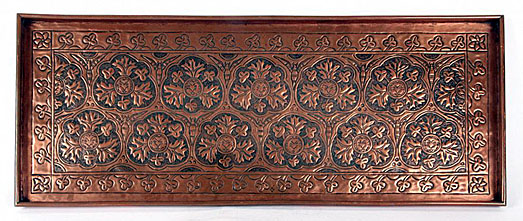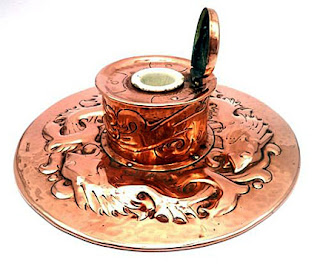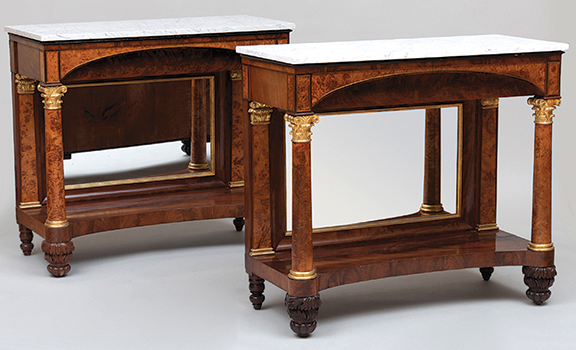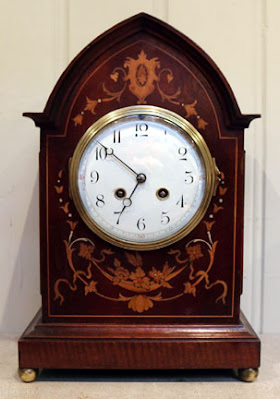 QUESTION: Recently, while browsing though an antique shop, I came across two tables. Both had fold-over tops. One seemed like it was from the 18th century, the other from the Empire period of the 19th. The dealer unfolded the top of the older table to reveal a green felt cloth inlaid into it. He said that this was a card table. When he unfolded the top of the second table, it had no felt inlay and was plainly finished. He told me the second table was a tea table. I always thought they were both card tables. Can you tell me the difference and when card tables started to be used?
QUESTION: Recently, while browsing though an antique shop, I came across two tables. Both had fold-over tops. One seemed like it was from the 18th century, the other from the Empire period of the 19th. The dealer unfolded the top of the older table to reveal a green felt cloth inlaid into it. He said that this was a card table. When he unfolded the top of the second table, it had no felt inlay and was plainly finished. He told me the second table was a tea table. I always thought they were both card tables. Can you tell me the difference and when card tables started to be used?
ANSWER: There’s a difference between the two tables, although subtle. Back in the 18th century, furniture was expensive as each piece was handcrafted to suit the customer. People woud have used their card tables as tea tables by just putting a tablescloth over it. But by the 1840s, furniture had begun to be at least partially machine-made, and manufacturers kept the cost down by making card tables plainer.
 Playing cards were probably invented during the Chinese Tang Dynasty around the 9th century as a result of the usage of woodblock printing. Playing cards became a diversion both in public houses and private homes. Early playing cards had neither suits nor numbers. Instead, they had instructions or forfeits for whoever drew them. Usually, playing cards revolved around drinking alcohol, especially in the public houses.
Playing cards were probably invented during the Chinese Tang Dynasty around the 9th century as a result of the usage of woodblock printing. Playing cards became a diversion both in public houses and private homes. Early playing cards had neither suits nor numbers. Instead, they had instructions or forfeits for whoever drew them. Usually, playing cards revolved around drinking alcohol, especially in the public houses.
The earliest game involving cards occurred on July 17,1294 when the Ming Department of Punishments caught two gamblers, Yan Sengzhu and Zheng Pig-Dog, playing with paper cards. The Department confiscated the wood blocks used for printing the cards together with nine of the actual cards. By the 11th century, playing cards had spread throughout Asia and eventually made their way to Egypt. Playing cards probably came to Europe from the East, arriving first in either Italy or Spain.
 By the early 18th century, specially made tables for playing cards began to appear all over England. The first card tables first appeared in the American Colonies around 1710. Card tables became symbols of wealth and the consequent expansion of leisure time and soon became a social necessity in every fashionable home. Without modern entertainment devices, about the only forms of evening entertainment was playing music, dancing, and of course, playing cards.
By the early 18th century, specially made tables for playing cards began to appear all over England. The first card tables first appeared in the American Colonies around 1710. Card tables became symbols of wealth and the consequent expansion of leisure time and soon became a social necessity in every fashionable home. Without modern entertainment devices, about the only forms of evening entertainment was playing music, dancing, and of course, playing cards.
Cabinetmakers constructed most of these imported English card tables of mahogany or walnut. Each had a hinged two-leaf top that, when open and supported on a swing leg, revealed an inner surface lined with leather, felt, or the coarse woolen cloth called baize. Since household lighting was usually inadequate for evening play, most of the tables had four turrets projecting from the corners to accommodate candlesticks. In addition, there were often “guinea pools” or “fishponds”—shallow dishlike depressions to hold money, dice, or counters—and, in Chippendale styles, a single drawer in which to keep the cards. The tables stood on graceful cabriole legs, meant to resemble a woman’s shapely calves, but their backs, unseen against the wall, remained unfinished.
 Since so many of these tables were highly decorative and also bore their makers’ marks, they provide valuable evidence of the varieties of carving, inlay, veneer, and other detail used by the cabinetmakers, as well as of regional characteristics. Tables with bowed fronts were popular in Boston and Salem, and five- and six-legged examples appeared in New York.
Since so many of these tables were highly decorative and also bore their makers’ marks, they provide valuable evidence of the varieties of carving, inlay, veneer, and other detail used by the cabinetmakers, as well as of regional characteristics. Tables with bowed fronts were popular in Boston and Salem, and five- and six-legged examples appeared in New York.
Some people used card tables for purposes other than for playing cards. Unfortunately, tablecloths only covered over the fishponds, often causing accidents and breakage.
In Puritan New England and Quaker Philadelphia, as well as in the South, people bet huge sums on cockfights and horse races, on bull and bearbaiting. Doctors and lawyers would wager their fees at the card table, and the “devil’s prayer book”—a deck of playing cards—could be found everywhere.
 From the beginning of the United States, gambling overpowered every effort to restrain it. By the late 18th century every fashionable home had a card table. Still, most households reserved the card table for recreational use.
From the beginning of the United States, gambling overpowered every effort to restrain it. By the late 18th century every fashionable home had a card table. Still, most households reserved the card table for recreational use.
In the upper-class 18th-century American home, ladies played cards at afternoon tea parties where guests might win or lose hundreds of dollars. In the evening, families would summon servants to bring the card table into the center of the drawing room after dinner, as card playing was a primary form of evening entertainment. Players became embroiled in spirited games of whist, a simpler foreunner of bridge, pokerlike brag, quadrille, or any of the several other games while spectators observed the action.
 When not in use, card tables in most households remained folded away to become consoles or side tables. Servants set card tables against the wall when not in use, sometimes with the upper half raised as a kind of ornamental backsplash.
When not in use, card tables in most households remained folded away to become consoles or side tables. Servants set card tables against the wall when not in use, sometimes with the upper half raised as a kind of ornamental backsplash.
After about 1840, card tables began to lose the felt inlaid on their surface. People still played cards but now these tables came into popular use as tea tables. With a smooth top, minus the fishponds and candlestick rests—indoor lighting had been much improved—it was now possible to place a tablecloth over the table without the fear of anything toppling due to the former depressions. In many cases, these table featured graceful rounded corners and were still being made of mahogany or walnut.




















































